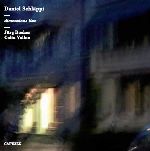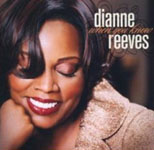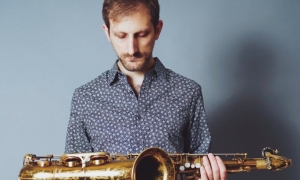Home » Jazz Articles » Interview » Jaleel Shaw: Almost There
Jaleel Shaw: Almost There
If you are happy and love what you are doing, that should be the ultimate goal. For me, I am happy, I love what I am doing - come on, I am playing with Roy Haynes!
 Barely thirty, alto saxophonist Jaleel Shaw has was won two ASCAP Young Jazz Composer awards, received the Billboard Endowed Scholarship for Outstanding Academic and Musical Achievement (1998), the Outstanding Student Teacher Award, The Boston Jazz Society Award (1999) and he was also a finalist in the Thelonious Monk International Saxophone Competition (2002).
Barely thirty, alto saxophonist Jaleel Shaw has was won two ASCAP Young Jazz Composer awards, received the Billboard Endowed Scholarship for Outstanding Academic and Musical Achievement (1998), the Outstanding Student Teacher Award, The Boston Jazz Society Award (1999) and he was also a finalist in the Thelonious Monk International Saxophone Competition (2002).Currently Jaleel holds a regular seat with the Roy Haynes Quartet and the Mingus Big Band. He's also released Optimism (2008), the follow-up to his 2005 Fresh Sound New Talent debut as a leader, Perspective, on his new Changu label.
Chapter Index
- New CD
- Influences of Hip-Hop
- Working with Roy Haynes
- The Mingus Big Band
- Background and Influences
- Heading to New York
New CD
All About Jazz: Your new CD Optimism, did the finished product come out how you envisioned the music sounding when you went into the studio?
Jaleel Shaw:: It did and it did not at the same time. Originally I intended for an acoustic set, but the CD has some Rhodes and I did not plan to have any Rhodes electric piano, except possibly on one song. We arrived at the studio, the Rhodes was there, and [pianist] Rob Glasper would suggest using the Rhodes on this or that song. It sounded good, so we just went with it. Besides the use of the Rhodes, it turned out exactly how I wanted the CD to sound. I wrote at least four of the tunes on this CD around the same time as I finished my first CD [Perspective], so the music was there. The exceptions were the interludes; they were written in the studio.
AAJ: Guitarist Lage Lund also embraces the use of electronics by loops and pedals.
JS: Lage always uses effects; you might miss them if you are not listening closely. On the tune "Muna's Dream," we had Lage go into a room and play some light effects. But after listening to it, I said, man, I want to play over this. The use of electronics opens so many possibilities. They made me think about being as open as possible in my writing, instrumentation, or with anything in the music. Sometimes I find I am always thinking about acoustic settings,
It is a long process, the mixing and mastering. I hope one day to do a strings album and a big band album. The doors have been opened in so many ways, so why not take advantage?
AAJ: The new CD is on your own label, Changu. Tell us about your label.
JS: It started with me not having the best experience with my first CD [Perspective] as far as a label goes. I really wanted to see this business as someone who owns a label. I wanted to see how many CD's I sell, what it is like to deal with a publicist, what it is like to advertise. That way I can see how my sales are going, how my publishing is going. I saved up the money to do the CD, and I thought maybe I would do the CD and shop it around to someone. In the end I felt that I had put too much into the CD to shop it around, so I decided to put the CD out myself.
A lot of younger guys are doing the same thing; you have Marcus Strickland, Mike Moreno and Kendrick Scott. We are making and releasing our CD's on our own. With Tower Records gone, who knows what is going to happen with record stores—especially with iTunes and the rest of the on-line distribution companies taking over. If you can sell your own music on-line, why not own it?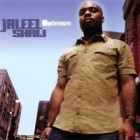
AAJ: What have you learned so far as label owner?
JS: Someone told me that when it comes to sales, jazz is at the bottom of the totem pole. I have not seen any results yet, because the CD is just coming out. I am conscious of the fact that I may not sell a lot of CD's. Although I have learned that it costs a lot of money and takes a lot of work, we started in June 2007, and I am still not done. I want to do some more advertising, and I still have been working on the CD. It has taken a lot of time away from me practicing, or working on new music.
AAJ: Your first CD was on the Fresh Sound New Talent label. How did a Philly musician wind up on a Barcelona-based label?
JS: Before the trend of putting out your own CD, everyone wanted to be on the FSNT label. I am not sure that it is the same today, [but] it meant something back then. Then, it meant you made it, you were part of the group. It was the label where young musicians started and made their mark. Kurt Rosenwinkel, Brad Mehldau, Seamus Blake, The Bad Plus, among others, were on the label before I came there.
class="f-right">
Influences of Hip-Hip
AAJ: In your liner notes you mention J. Dilla. Robert Glasper who is on the CD has also referenced hip-hop in his music. Can you discuss what influence hip-hop music has on the current generation of jazz musician, insomuch as it may have been part of the soundtrack of their youth?
JS: I cannot really speak for everyone.
AAJ: For the older generation of jazz musician, the Great American Songbook was the soundtrack of their youth. For the current generation, they have grown up with hip-hop and alt rock as their soundtrack.
JS: For me I grew up listening to it. I was born in 1978, which is supposed to be the year hip-hip started. I grew up hanging with my cousins listening to hip-hop, and I used to break dance when I was little. I was always a hip-hop fan. There is a group called A Tribe Called Quest. When I first heard them, they took me someplace else; they really inspired me. Some people do not like to say this; I could tell they were inspired by jazz music.
That brought my world together, because on one hand, there I was with peers that did not listen to jazz and could not relate to what I was doing. On the other side, I grew up here in Philly with guys who were listening to jazz. Both worlds started to come together when I started listening to A Tribe Called Quest. From there I got into Da La Sol and The Roots. The Roots were from Philly, and I was able to sit in on their jam sessions. I still listen to hip-hop and feel that J. Dilla is amazing.
When I write today, it is hard for me to say, okay I am a jazz musician and won't put any other influences in my music. For example, I love Ravel, Bjork, Radiohead, James Brown, and I also love Charlie Parker, Cannonball Adderley, John Coltrane and Wayne Shorter—that is just who I am. The one thing when I think about jazz today is that people are afraid of being who they are, based on what the authorities say is jazz. One has to be who you are in the music. Jazz music is an art form, we are artists. When you think of an artist, they draw something from their perspective. Therefore, I draw my music from my perspective, from my environment, and from the experiences that I have had.
class="f-right">
Working with Roy Haynes
AAJ:How did you begin your association with the legendary Roy Haynes?
JS: It started with me subbing for a tenor saxophonist named Walter Smith, whom I believe was himself subbing at the time. He was leaving to attend the Monk School in Los Angeles. Walter called and said Roy is looking for a saxophonist, do you think you want to do the gig? He said that Roy needed me for a tour of Europe and a week at the Iridium in New York, but the first gig was actually in Vermont. Walter and Roy's bassist John Sullivan both recommended me to Roy. When I said that I could do it, I basically had the gig.
Roy still had not heard me play. Then a week after I spoke with the booking agent, Roy called and said, why don't you come over so I can hear you play? Roy's place is in upstate New York, and I went there and we played some duos. He did not say that I had the gig; he sat down and started to talk to me. He was talking about styles and how he once had an offer to play in Duke Ellington's band and he turned it down. He said that he knew the direction he was heading musically and the fact that he could turn that down, at the time that was a big decision—turning down Duke Ellington.
We went on tour, and during the first gig a promoter in France was talking to Roy. Then Roy looked over at me and said to the promoter, "I do not know." Then Roy came over to me and asked if I could make the gigs next year. I was thinking after the current tour was over, that was it. So I told Roy that I was free next year, and then I stayed on with the band.
AAJ: Can we go back to that first meeting with Roy at his house?
JS: It was crazy. I was nervous, but when I walked in and started talking to him, I was relaxed. After playing the first song, I was completely comfortable. He is cool, he is a human being, he is a legend, but he made me feel like we are both human beings.
AAJ: How did it feel the first time you took the stage in Roy's band?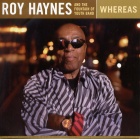
JS: I was nervous—not just because it was my first time with Roy; it was my first time with a small group in front of huge audience. A small group differs from a big band. It challenges your endurance, and it is different on your chops. My chops did develop fast! That first night was rough. I was very nervous but was comfortable playing with Roy. At the same time, it was a relief. I really wanted to play in a small group, and now it was finally happening.
AAJ: Now that you lead your own small ensemble, what, if anything, have you learned from Roy that you incorporate into your leadership style?
JS: Wow! To be honest with you, I have not had too many gigs with my band. The one thing that Roy reinforces is to let everyone be who they are. I was talking with someone the other day, and he said the leader of that band told them what to do and what to play. Roy never told me to play anything. He hired me because he wants me, and I have something to say that he can use. When you want to use someone in your music, you have to make sure they fit. If they do not fit, do not try and change them. Go in a different direction, find someone else.
class="f-right">
The Mingus Big Band
AAJ: You are also in the Mingus Big Band. How did you get that gig?
JS: Drummer Johnathan Blake was playing in the band, and I was attending Manhattan School of Music and living in New Jersey. I did not have a car at the time, and I had a late class every Thursday that ended around 7:30, 8:00 pm. The Mingus Big Band started their sets at 9:00 on Thursday, so after my class I would head down to catch them and get a ride home with Johnathan, as he lived in my apartment building in New Jersey.
I would hang out, catch the band, and I had my horn with me, as I was coming from class. One night I was asleep in the back, and I heard someone call my name to come on stage and play. The next day Sue Mingus called me, and that was it. I have been playing with them for eight years now.
AAJ: Describe the difference in playing in a small ensemble versus a big band.
JS: First, in a big band you are not soloing as much. It is more about blending and hearing other musicians and supporting each other. I look at it as a big fortress, and we are all supporting each other. The rhythm section is the foundation, and then you have trumpets and saxophones...
With a small group like Roy's, we are all supporting each other, but we have bigger jobs since there are only four of us. For me as a horn player, I have to know the melody. Roy is a stickler for melodies. I can't tell you how many times I played a melody I thought I knew—I guess I heard off a record or got it out of a fake book—and Roy would stop me. Whenever we are about to go on stage, or at a sound check, Roy will ask, what do you want to play? I would call a song, and Roy will say play it. If I play one note wrong, or the rhythm wrong, or if a phrase is wrong, Roy will stop me and say it is not right. He will sing it to me, and we will continue back and forth until I get it right. For me, I have to be on point—not just for the audience but for Roy. Roy knows all the melodies; I mean, he knows the lyrics.
In the big band, not that you should, but if you make a mistake, it is not as noticeable as if you made it in a small group.
class="f-right">
Influences and Background
AAJ: Was there one musician whose music that you transcribed and/or went to the shed with regularly?
JS: I probably did that most with Cannonball. He has a great sound. He has everything.
AAJ: Was it only saxophonists that influenced you, or were there other musicians?
JS: I would have to say a lot of saxophonists. Bobby Watson, a lot of Bobby, he was my first huge influence. When I was in Lovett Hines' group, every time he drove me to a gig or back and forth from practice, he would play Cannonball, Sonny Stitt, Maceo Parker, Kenny Garrett, Antonio Hart in his car. I am not sure if he was doing that on purpose, or if it was a coincidence.
For me, it would have to be Bobby Watson. I love Johnny Hodges and Cannonball Adderley and of course Bird and Lee Konitz. Everyone—there really is no one that I did not check out. As far as pianists, it would be McCoy [Tyner], Herbie [Hancock], Sonny Clark and Mulgrew Miller.
AAJ: We are going to back up now. Tell about your background; was there music in your house growing up?
JS: My mother loves all styles of music. That is how I got into being so open about different types of music. She has everything from Pharaoh Sanders, Yusef Lateef and Trane. She was really into that period and everything. Tchaikovsky—I remember when I was a little kid, she took me to see the Nutcracker Suite. I went nuts; I had to have the record and I listened to that record over and over. Music was definitely played when I was a little kid. I remember dancing as a kid to Miles Davis' Tutu. I would put that record on myself when I was a kid and dance along. When I was four, she took me to violin lessons. At six, I took piano and drums.
When I was eight, a guy came to my elementary school and played a cartoon of the history of music and instruments. You can still see that cartoon, as it is on the DVD Fantasia. Anyway, when I came home from school that day, I told my mom that I wanted to play an instrument. I wanted to play the drums, but somehow I wound up on saxophone. The school did not have a saxophone that year, so I started on clarinet. The next year I switched to sax. I was nine and that was it.
AAJ: Talk about your high school years and some of the alum from your school.
JS: My teacher was Lovett Hines, and at the time the school was named Settlement Music School. Mr. Hines moved from there to the Clef Club in Philadelphia. He was the most amazing experience I ever had. It was not about the school, it was about him. Anywhere he went, I would have followed.
AAJ: Why is that?
JS: He is a great teacher and human being. One thing I came to realize about teaching is that when someone has a great energy, I grasp onto them. Mr. Hines cares, and he inspired and motivated me like nobody except my mom. He taught Christian McBride, Joey Defrancesco, Kamal [from The Roots], Johnathan Blake—a lot of people came through him. I cannot say enough about him; it was an amazing experience. We would meet every Saturday and rehearse, learn new tunes, and he gave us the opportunity to play.
That is where I met Johnathan Blake, when I was about eleven. To this day, whenever I play, I play with Johnathan. To me, having that relationship with Johnathan at an early age was important. When I talk about my peers listening to hip-hop, at the same time, I had Johnathan, Duane Eubanks, and other friends who I could call and say, "Hey man, check out this Wayne Shorter or Lee Morgan tune." To me, that is what it is all about—us being in a great environment. Mr. Hines was great for me.
AAJ: From Philly you went to Berklee.
JS: In high school, I went to the Performing Arts High School and was actually discouraged from going to Berklee, and I have no idea why. Teachers always told me, do not go to Berklee, it is a horrible school. When I was thirteen years old, I had it in my head that I was going to Berklee. I remember being interviewed by another student when I was thirteen in high school, and they asked where I saw myself in five or six years. My response was, I saw myself either at Berklee or the Manhattan School of Music, and from there I wanted to play professionally. I was always determined that I was going to Berklee. When I was sixteen, my mother took me to Berklee to audition for a summer program, and I was offered a partial scholarship. I did not attend that summer because, even with the scholarship, it was too expensive. When I was seventeen, I auditioned again, and I received a full scholarship to attend Berklee. Mr. Hines and Berklee—I do not know where I would be without them. At Berklee I was around a lot of great young musicians.
AAJ: Lage Lund was there.
JS: Exactly! Lage, Jeremy Pelt, Miguel Zenon, Wayne Escoffery, Avishai and Anat Cohen, Patrick Cornelius, Kendrick Scott, Walter Smith, Helen Sung, Warren Wolf, and Julius Tolentino was in the area. There were a lot of us up there [laughing]; it was amazing. Bassist John Sullivan who helped me get the gig with Roy Haynes was there. I had great teachers; I studied with Billy Pierce and Andy McGee. Berklee was a great experience.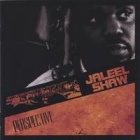
Where I lived was two blocks from school and four blocks from a club called Wally's. Wally's is the club where Berklee students from the 1970's to the present play and hang. Branford [Marsalis], Donald Harrison, Kurt Rosenwinkel, Mark Turner—all these cats played at this club. Wally's was the hang. Every weekend I went down there and would sit in. The club is tiny, but every cat would be trying to play. There was a jam session that started at midnight. I was playing all of the time, so Berklee and Boston were an amazing experience I had musically. It really inspired me to practice. You could practice from 10:00 am until 2:00 am, and it was great.
AAJ:
And from Berklee?
JS: [Laughing] All I can say is that I went to grad school at the Manhattan School of Music—that is all I can say about that—and I received my degree in performance.
class="f-right">
Heading to New York
AAJ: Masters Degree in hand, how did you as a young musician break into the NYC scene?
JS: Honestly, I think I am still trying to break into the New York scene in some ways. That is, "The New York Scene." I am not talking about the jazz musicians or jazz networking; I feel I have somehow broken into the jazz network from playing with Roy and the Mingus Big Band gigs. As far as getting my own gigs with my own band, that is extremely difficult. A lot of the clubs are very cliquish and exclusive. You can go to one club and see the same person playing there once a week or more.
It is hard. So far, I have performed at the Jazz Gallery regularly. The other clubs I have not really been able to break into. It is wild. You think when you get to New York that everything is going to be cool. If you practice and work hard, you are going to get in. But it is very political, and a lot of it does not have to do with how well you play. It has to do with who you know and who likes you on a personal level. Again, I am not saying that there are not great musicians playing at these clubs—there are great musicians. I am just saying that it is hard, really hard, to break in. It takes a lot of networking. Maybe since I have been playing with Roy and the Mingus Big Band, my time is limited, and it is hard for me to network the way I would like. I would love to go to these clubs and bug them like I should.
I remember arriving in New York and speaking with musicians who arrived a generation before me—like Antonio Hart telling me that it was so easy. You arrived and got a record deal and gigs. When I arrived, it seemed like everything stopped. Labels stopped signing people, artists were being dropped.
AAJ: : I remember, Mark Turner was dropped around that time, and it was a big thing.
JS: Right! I remember when Mark was dropped. I was supposed to study with Mark at Manhattan, and he quit a week before school started. We stayed in contact and he is one of my favorite musicians. I remember Mark telling me that he was dropped. That is when I really got scared. If Mark Turner is not signed to a label, then what does it mean for the music?
 My mom always reminds me that I could be making a lot of money and still not be happy. Sometimes if I am not gigging, or if I do not like a gig, I have to remind myself that I am doing what I love and I have control. I can turn down a gig. I am not stuck in anything. You can always leave, and another opportunity will turn up.
My mom always reminds me that I could be making a lot of money and still not be happy. Sometimes if I am not gigging, or if I do not like a gig, I have to remind myself that I am doing what I love and I have control. I can turn down a gig. I am not stuck in anything. You can always leave, and another opportunity will turn up.
If you are happy and love what you are doing, that should be the ultimate goal. For me, I am happy, I love what I am doing—come on, I am playing with Roy Haynes! That is a dream. That overshadows everything. It overshadows the business, the financial aspects of being a jazz musician. If you keep that in mind, it eliminates any doubt you may have.
When I arrived in New York, I was scared. I was never that afraid in my life. When students come to me and ask how can they break into the scene... I really had no idea how it was going to happen for me. Fortunately I got into the Mingus Big Band. There are a lot of people who have been in New York for years and have not made it happen. It is all about opportunity, having the opportunity. Sometimes I think there are enough clubs, just not enough opportunities. Club owners and booking agents need to be more open. The people who are the most open are the musicians. When you get down to the critics, the clubs, it closes; they are not open to the fact that the music is art. It is not sports, it is not different groups, it is art and should be wide open. But it is not.
AAJ: You have received quite a bit of recognition for your composing. Do you consider yourself more of a composer or saxophonist?
JS: I would have to split it down the middle, although people hire me to play my sax. People are not hiring me to write music.
Selected Discography
Jaleel Shaw, Optimism (Changu, 2008)
Roy Haynes, Whereas (Dreyfus, 2006)
Rick Parker, Finding Space (WJF Records, 2006)
Jaleel Shaw, Perspective (Fresh Sound New Talent, 2005)
Mingus Big Band, I Am Three (Sunnyside Records, 2005)
Photo Credits
All photos courtesy of Jaleel Shaw
Tags
PREVIOUS / NEXT
Support All About Jazz
 All About Jazz has been a pillar of jazz since 1995, championing it as an art form and, more importantly, supporting the musicians who make it. Our enduring commitment has made "AAJ" one of the most culturally important websites of its kind, read by hundreds of thousands of fans, musicians and industry figures every month.
All About Jazz has been a pillar of jazz since 1995, championing it as an art form and, more importantly, supporting the musicians who make it. Our enduring commitment has made "AAJ" one of the most culturally important websites of its kind, read by hundreds of thousands of fans, musicians and industry figures every month.



